Planning a trip to the Lofoten, Norway
If you are planning a trip to the Lofoten and are looking for tips, here you’ll find the best advice I can give you on planning a road trip, the best hikes, and how to enjoy your stay best.
If you landed on this page, you are most likely already aware that the Lofoten Islands are an amazing travel destination for adventurers seeking natural beauty and breathtaking landscapes. Located within the Arctic Circle, you can experience its unique landscape, but also the midnight Sun in Simmer and the Northern lights from autumn until spring. Top that off with its dramatic mountains and beautiful beaches and you have the ingredients for a very unique vacation.
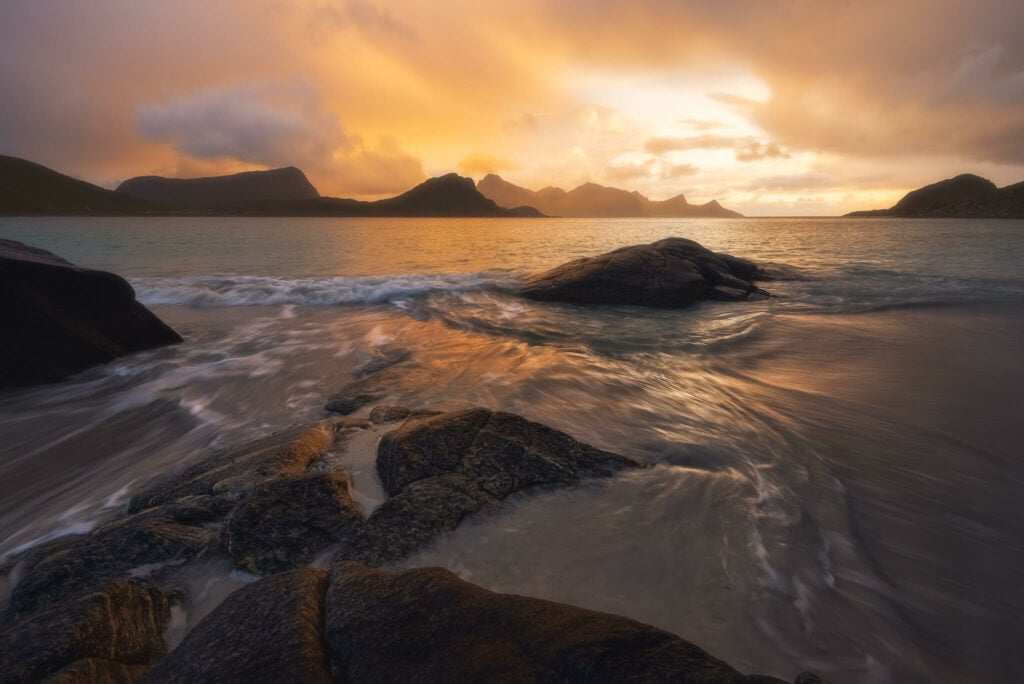
Sunset at Haukland Beach, September 2017.
A word of warning: if you visit you are likely to catch the Lofoten Bug :)! I know I did. I have visited several times over the last ten years. It’s one of my favorite destinations and one I keep going back to. Yes, I already do have plans for my next trip too. In this post, I want to share my experience and tips for you to plan your own trip at best and make the most out of it.
When to Visit the Lofoten Islands
Planning a trip to the Lofoten Islands is no easy task. It is a remote location within the Arctic Circle, after all. The weather can be extreme here and the season you visit can make a huge difference. So the first recommendation would be to think about what you want to experience and then plan accordingly.
For instance, you may not want to visit in winter during the polar night from mid-December to mid-January..unless you want to experience that.
In February and March, you have a decent amount of daylight, and you can catch the famous snowy landscapes and the northern lights but hiking opportunities are limited.
In June and July, you can experience the magic midnight sun, but this is the peak of the tourist season, so there will be hordes of other visitors around.
Personal Tip: September is my absolute favorite month to visit. Most of the tourists would have left the islands already. Prices, especially for accommodations are cheaper. All the major points of interest are fully accessible. You have an almost equal amount of daylight and darkness, on average, so you can sightsee or hike during the day, and go on a Northern Lights chasing expedition at night. Fall colors start to kick in
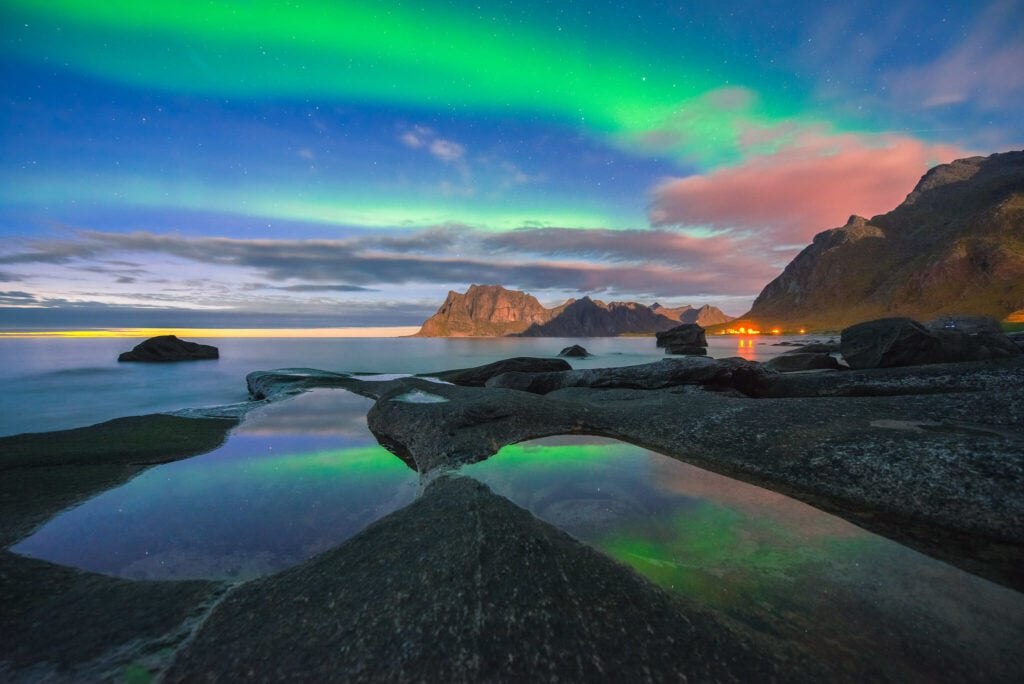
Northern Lights at Uttakleiv beach.
How to Get to the Lofoten Islands
There are several different ways you can get to the Lofoten Islands.
Before getting into the details, you should know that getting to the Lofoten takes time. Unless you already live in Norway or a nearby Scandinavian country, it will likely take you almost a full day of travel to get there from mainland europe. While that is a long time, this also gives you the advantage of being able to plan your travel to the Lofoten following the itinerary you prefer. For this reason, I’m not only going to list the best options available to get to the Lofoten but also the pros and cons of each. Let’s Start!
Lofoten from Bodø with Ferry
Bodø is a small and beautiful town, with its own Airport that mostly serves Norway. At the time of writing (2023), there only is one direct international flight getting to Bodø, from Helsinki. So unless you live there, this means you will have to get one international flight to get to Norway, a domestic flight to get to Bodø, rent a car and then take the ferry.
The ferry runs on average 2-3 times a day, so you’d have to plan your arrival with enough time to collect your bag, pick up your rental car and drive to the dock. I’d recommend planning to arrive with several hours to spare, just in case a flight is late and to absorb any possible delay. If you arrive on time, you can spend your time doing groceries and buying your gas canister if you are camping, or just taking a stroll around Bodø.
I highly recommend booking the ferry in advance, especially during the summer months. you can check the ferry schedule, and prices to book your tickets here. The ferry also is a good option if you don’t have a car. From the airport, you can take bus #1 or #2 from Bodø Lufthavn. the Bus ride takes about 10 minutes, and it’s a five minutes walk from the bus stop to the dock. Also, you don’t need to book the ferry if you don’t have a car.
The Bodø-Moskenes ferry takes about 3,5 hours.
- Pros: easiest to get to, well connected and you have a ferry ride directly to Moskenesøya, very close to some major points of interest and to Reine. A great option if you are not renting a car.
- Cons: ferry departure times are not always convenient, so you may have to spend a few hours waiting for the ferry
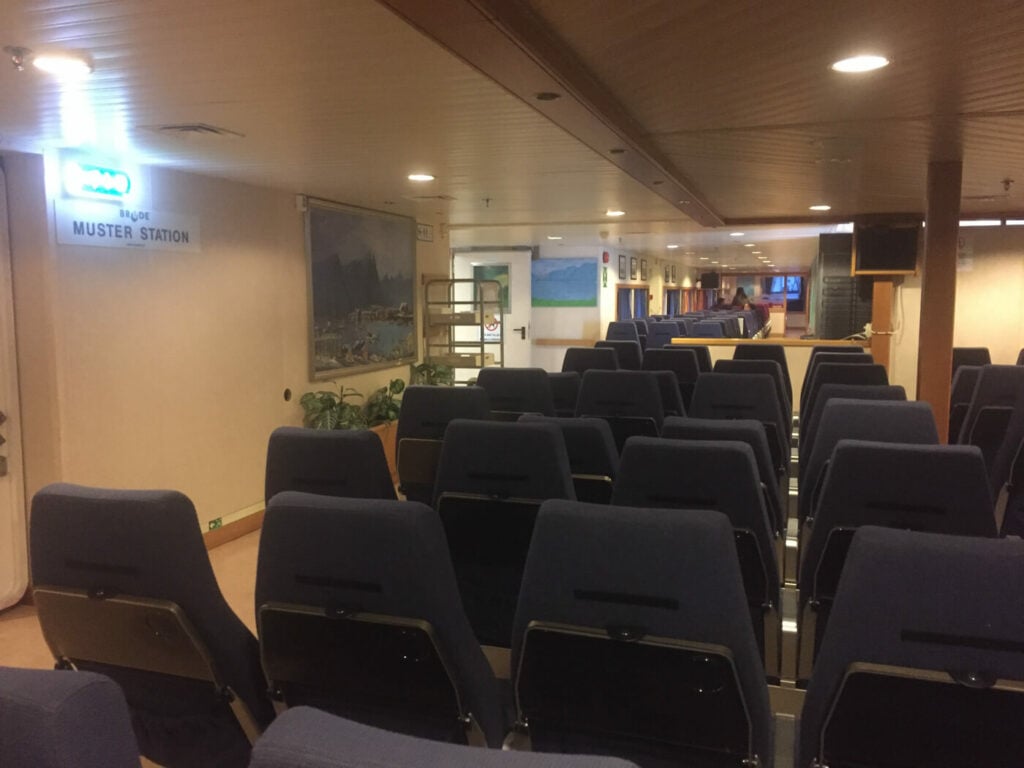
The inside of the Ferry
Lofoten from Narvik-Harstad Airoport (Evenes)
The Harstad/Narvik (EVE) airport in Evenes is a small airport located somewhat in between the towns of Harstad and Narvik. There is not much in the immediate vicinity of the airport in terms of infrastructure. This really makes you feel like you’ve landed in a faraway land, which I think is a great start to any holiday.
This is also the most budget travel Lofoten Islands for two reasons:
- The Airplane fare to Evenes is usually cheaper compared to either Bodø or Leknes.
- You can actually take a bus from the Evens airport all the way to Reine, or stop somewhere in between. The cost of a Bus ride from the Evenes airport to Reine currently is 512 NOK (a little less than 50 USD or Euros as of May 2023). You can check and plan the bus ride here.
Traveling by bus is not the most time-effective way to move around the Lofoten islands though, but if you have the time and are not in a hurry this is the cheapest option.
- Pros: usually the cheapest option, great if you are planning to visit all of the Lofoten’s islands along scenic E10 (Kong Olaf) road,
- Cons: the drive to Reine takes almost five hours without stops, so this isn’t the best option if you are planning to spend most of your time in the southern parts of the Lofoten Islands.
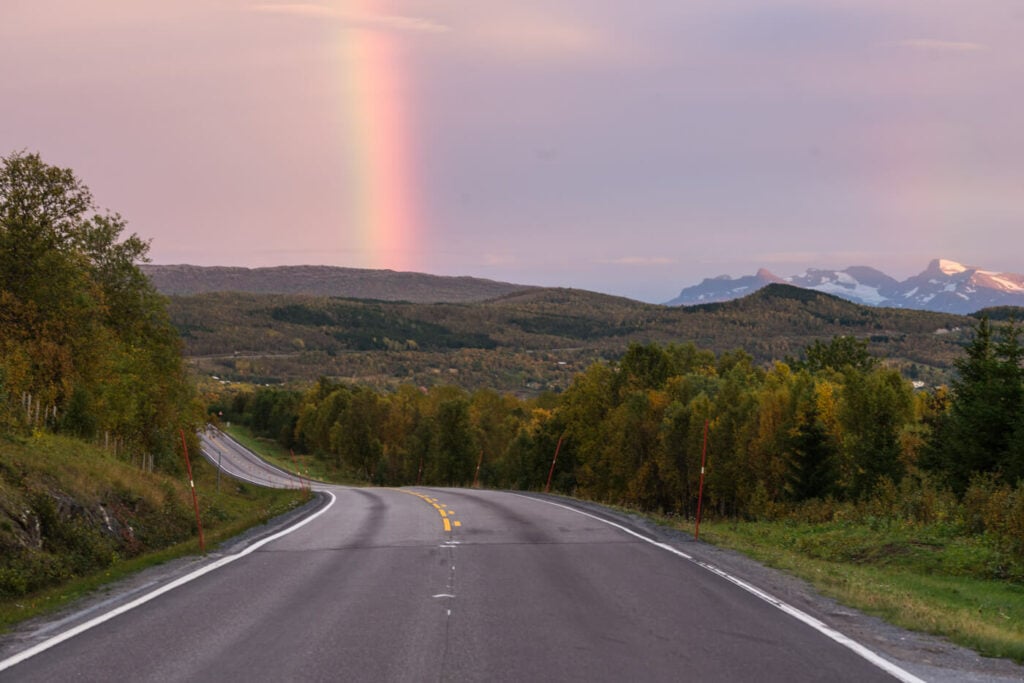
Road E10 just outside the Evenes airport.
Lofoten via Leknes
Flying to Leknes is the most direct way to get to the Lofoten. Actually, You’d be landing right in the middle of it. Only domestic flights land here and arrival/departure times are not always optimal. For instance, coming from mainland Europe, my best options were arriving after 10pm and departing around 6 AM. If you factor in Luggage pick up and drop off, it takes even more time.
Plus, you will be adding one extra flight on top of two more, usually. Three flights in a row aren’t exactly fun unless you really like to fly. The Leknes airport also has some rental car options, but somewhat limited.
- Pros: you are landing right in the heart of the Lofoten Islands, just a short drive away from locations like Vik or Utakleiv beach, or hikes Mannen, Veggen, or Offersøykammen.
- Cons: One extra flight that does not save much time compared to other options
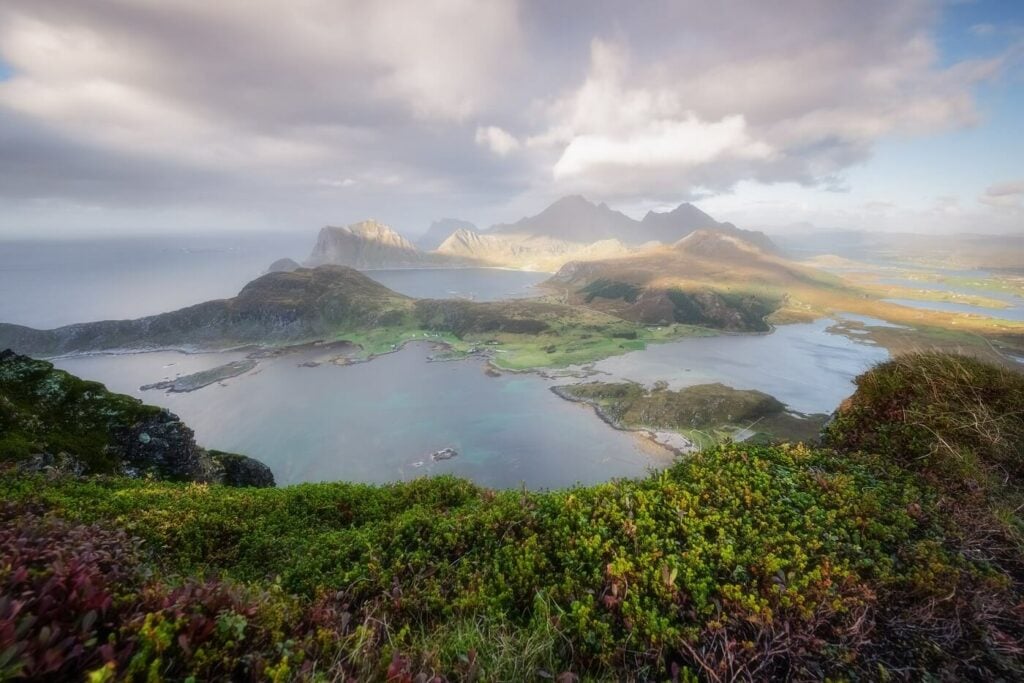
Beautiful hikes such as Offersøykammen are just a few minutes’ drive from Leknes
Lofoten Via Tromsø
Tromsø is the farthest away option in this list, but the airport is nicely served with direct flights from some major European capitals. So you’d save time in connecting flights.
The town of Tromsø is also a nice town well within the arctic circle. Definitely more than worth a visit in itself.
The downside is Tromsø is rather far from the Lofoten Islands. For example, a drive to Reine will take about 10 hours of non-stop driving. So this may be a good option if you are looking to spend an extended amount of time in the area visiting multiple locations. there’s plenty to see in between Tromsø and the Lofoten Islands.
- Pros: direct flights from some European towns, a beautiful destination in itself.
- Cons: far from the Lofoten islands, and requires a long drive.
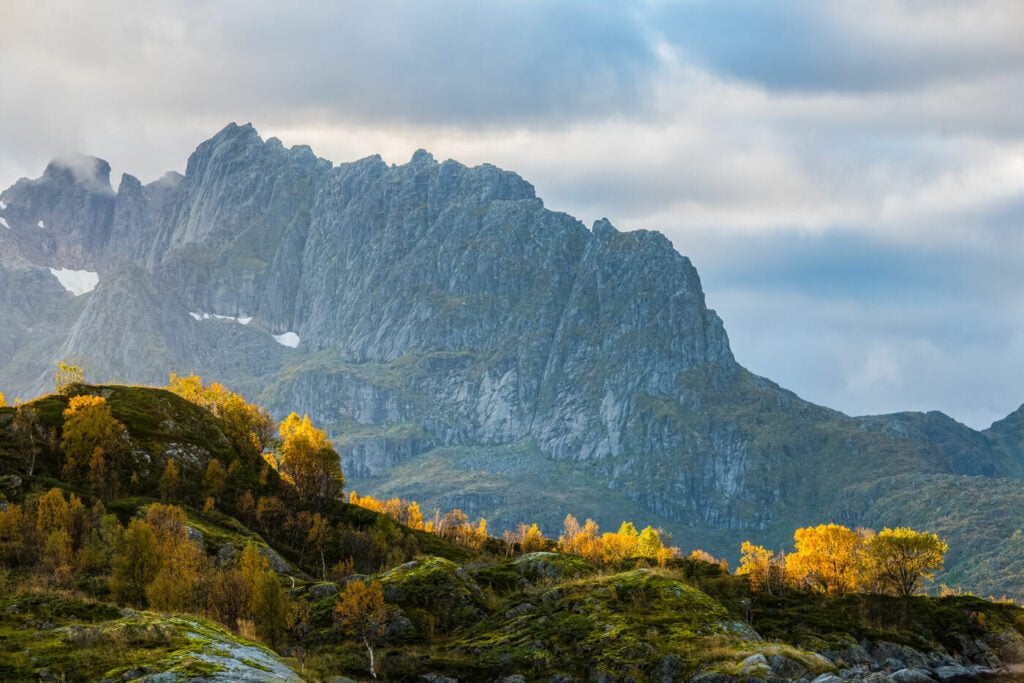
A random but beautiful scenery aling the E10 Kong Olaf road
Tips on Planning a Lofoten Road Trip
With flights out of the way, on to the next step of planning a trip to the Lofoten Islands. Renting a car; this is by far the best way to explore the region. There are plenty of scenic roads in the Lofoten; first of all, the E10 Kong Olaf Road. This road crosses the Islands from North to South and is a very scenic road. It’s just a beautiful drive through some magnificent landscapes. If you want to experience that, I’d recommend flying to Harstad/Narvik (EVE). Second of all, each side road may be the gateway to new discoveries!
Lofoten Car Rental Options
If you are looking for budget-friendly or cheapest prices, your best bet would be to search and compare prices on a car rental search engine. Here you can find the very best deals and offers for any of the locations and Major airports that offer car rental services.
Here is a list of tips to get the most out of your trip:
- Prepare a list of places you want to visit, some backups, and be open to new discoveries. The Lofoten Islands are a relatively small place, and you can easily drive around from island to island. I use this approach all the time and works great to optimize my schedule in terms of what to see. Also, you may find new places along the way. Be open to that, you may discover your next favorite place!
- Check the weather forecast daily: the weather in the Lofoten can and will change fast. Even if you have a plan, check the weather forecast in the morning to make sure you can do it.
- Keep a flexible schedule: If the weather is bad in one location, it may be better in another. Literally, in the next fjord too. That’s why you should have a list of places and check the weather daily. Don’t get stuck in one place because if the weather isn’t helping, you can move where it is better.
- Take your time: don’t rush it. you may be tempted to run from one location to another trying to see as many things as possible. Take your time, stop as often as you can, and take it all in!
- Make good use of Allemansretten, or the right to roam. If you are into that, camp when you can. Spend a day out on the trail and the night on a mountain away from. Also, note there are some areas where camping is forbidden. you can check the Lofoten camping restrictions map.
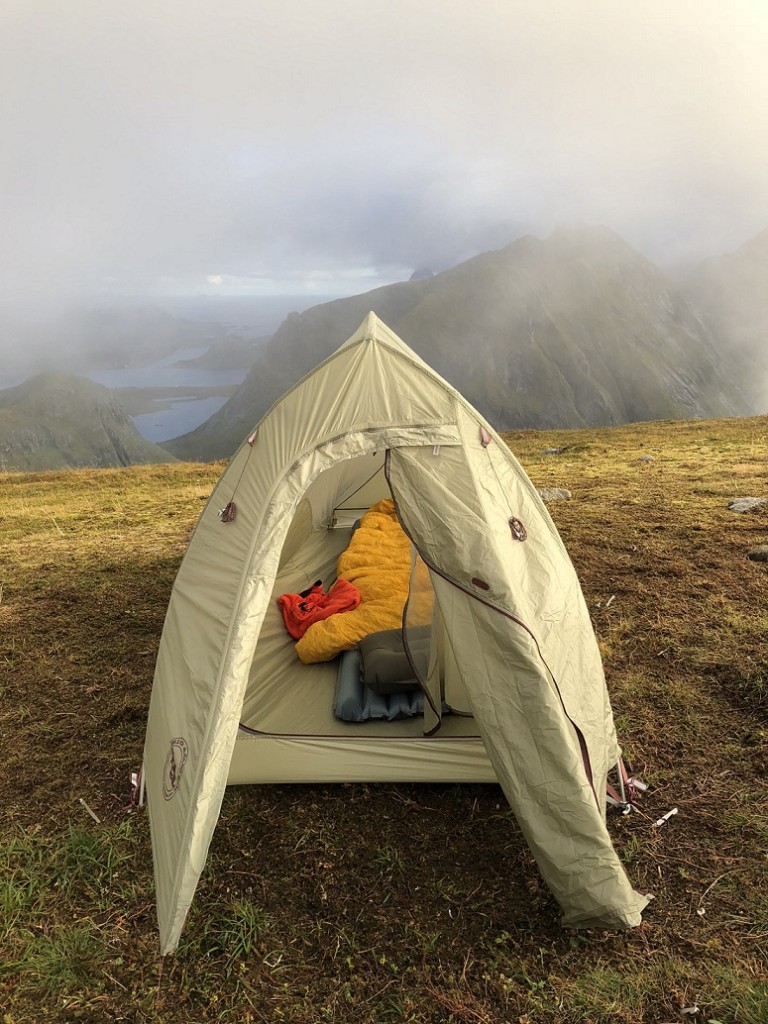
My trusty ultralight Big Agnes Fly Creek UL HV on Ryten, Lofoten Islands.
Driving in the Lofoten Islands
Generally speaking, the roads are very good and well maintained. This is not a given considering how hard the weather conditions can be here, especially in winter. Still, most roads are relatively narrow with some blind corners, so carefulness is always required. If you visit in Summer/early autumn, keep an eye out for sheep. It is not uncommon to see them grazing on the side of the road.
Here are some additional tips:
- Speed limits: usually 30km/h in some residential areas, or even 10km/h. Generally 50km/h in urban areas and 70/80km/h in rural roads and motorways.
- Keep headlights on at all times. This is mandatory.
- Don’t drink at all if you are planning to drive. The limit is 0.02%
- Handheld use of mobile devices is forbidden while driving.
- Parking: Free in most locations, but you have the occasional paid parking spot, like the Reinebringen Parking. Get the EasyPark app if you don’t have it already.
Hiking in the Lofoten islands
As you have probably guessed, this site is strongly focused on hiking so there are plenty here to choose from. From easier to hard, all-day hikes, you will be able to find some to your liking. I’d highlight recommend you try to go on an easy hike even if you are not a hiker. Hiking in the Lofoten Island is a fantastic experience and the views are breathtaking everywhere you go. Have the right equipment, be safe, and leave no trace.
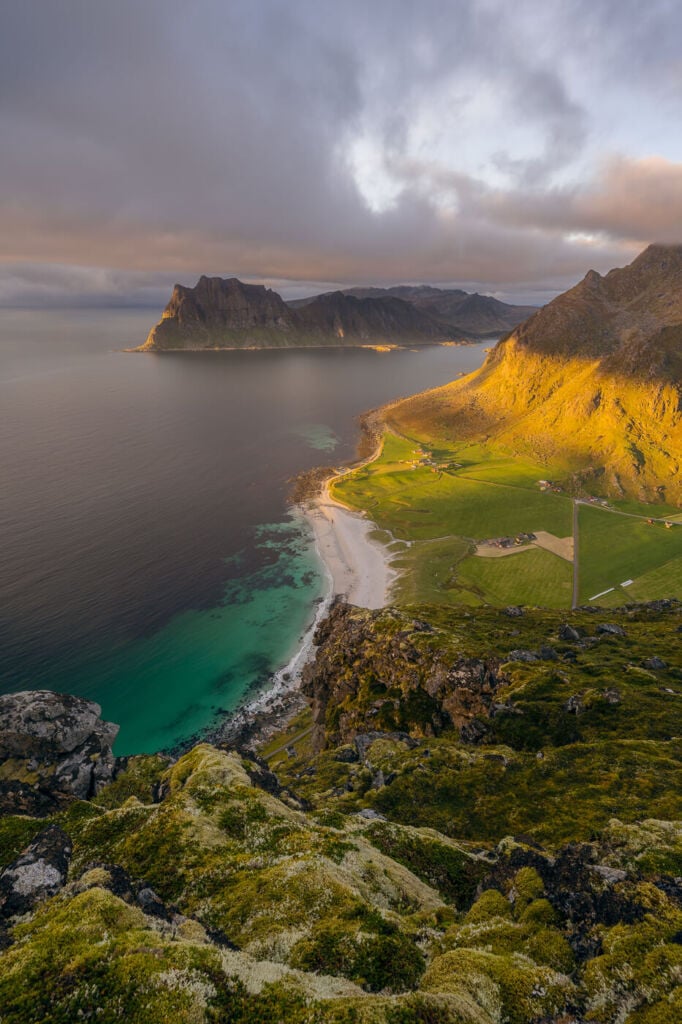
Sunset from the top of Veggen.
The First thing you should do is to familiarize yourself with the Lofoten Code of Conduct. It’s like the ten commandments to ensure a proper experience. Additionally, you can read my tips on hiking in Norway here too.
What to bring on a hike:
- Good boots/Hiking shoes with grippy soles. Ideally above-the-ankle waterproof ones. The terrain is often wet and muddy.
- Dress in layers and use Merino base layers. One mid-layer or two and a Jacket. More in Winter.
- Waterproof jacket and rain pants. You don’t want some light rain to stop you, do you?
- A Beenie, gloves, and neck warmer. Most likely not needed in summer but definitely a good to have.
- Sunscreen and sunglasses. Yes, you can get sunburned here. Also, sunglasses for driving. The sun can stay low on the horizon for long.
- Headlamp. Not needed in summer when there is the midnight sun, but you may want one later in the season, especially if you plan on chasing the northern lights.
- Food and Drinks. Bring more than you will need on your hikes. Also a water filter.
- Emergency Kit. Goes without saying.
- Maps. Either offline digital maps or Paper Maps.
Emergencies: The Emergency medical help phone number is 113, Police 112.
Lastly: leave no traces!
Ready to explore? Here you can find a list of my favorite and most scenic hikes in the Lofoten Islands and here is my YouTube playlist on hiking in Norway for some additional inspiration.
Also, here is a shortlist of my personal favorite hikes on the Lofoten Islands: Reinebringen, Ryten, Veinestinden, Offersøykammen, and Mannen.
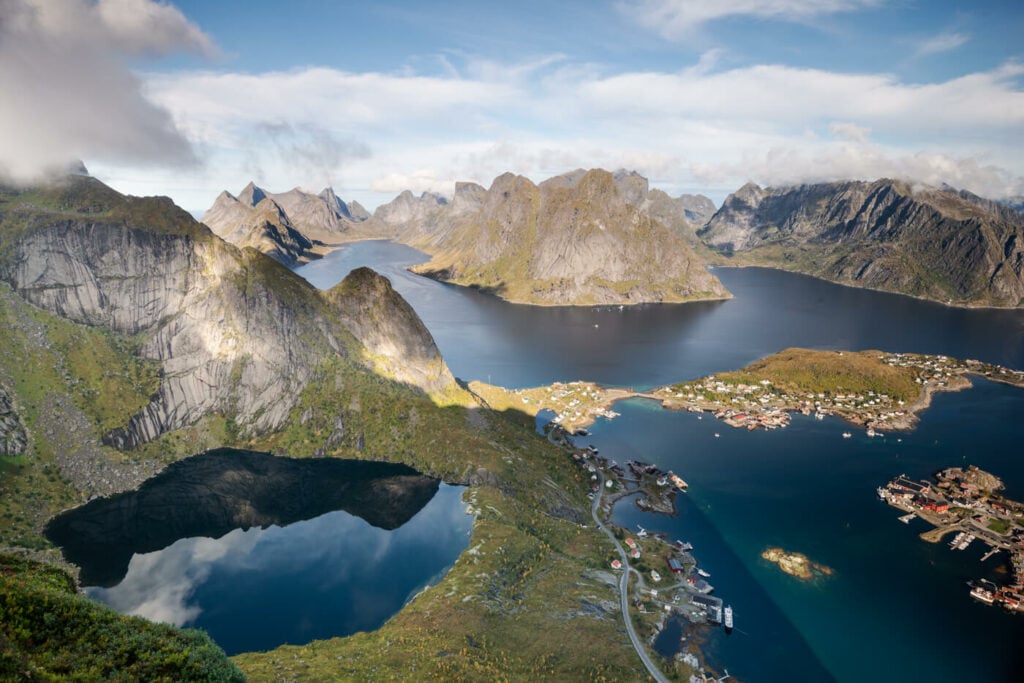
View from Reinebringen – a must-see location.
Northern Lights in the Lofoten Islands and the Best Seasons to view them
No secret the Lofoten Islands are probably one of the best places in the world to go on a Northern Lights Expedition. The dramatic mountain, the stunning beaches, and the whole area are the perfect scenery to view the Northern Lights. If you are planning a trip to the Lofoten to chase the Northern Lights, I’d recommend traveling around the fall or spring equinoxes. So more to less during the weeks around September 22nd and March 21st.
Why are the Northern Lights more visible during the Equinoxes? For reasons that are not fully understood, the lights seem to be more active in that period. Apart from that, in both cases, you will have enough daylight to do something during the day and change the lights at night. Also, if you are planning on doing some hikes, you should choose September over March. You won’t be able to do many hikes in March. On the other hand, you should visit in March if you are hoping to catch some snowy landscapes.
If you’d like to learn more about the northern lights and how to photograph them, check out my other two posts on “How to see the Northern Lights” and “How to Photograph the Northern Lights“.
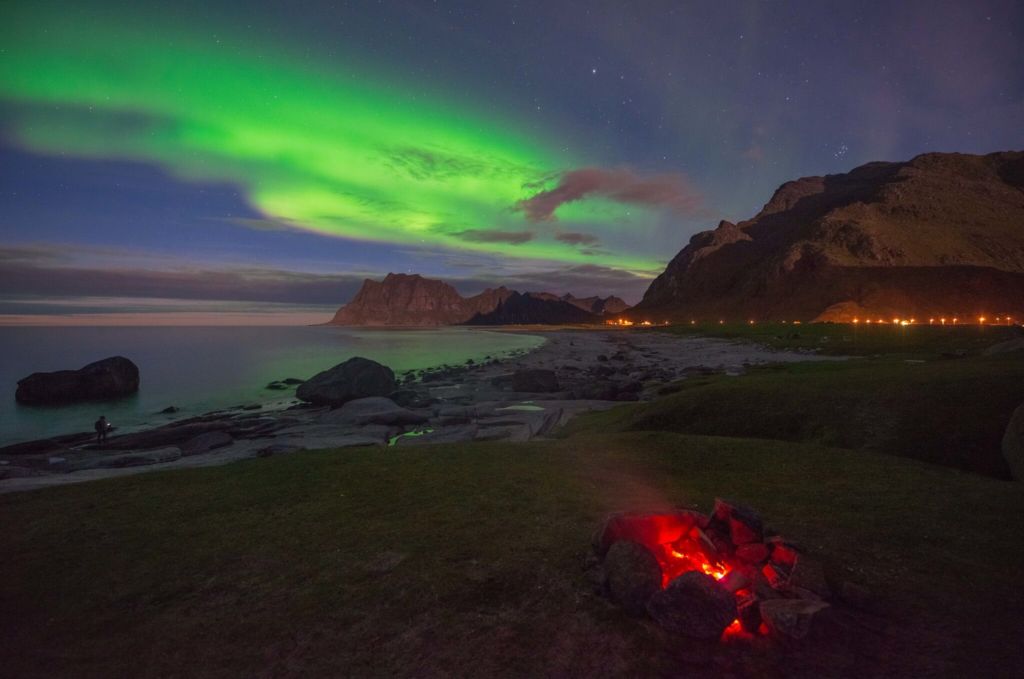
Watching the Northern Lights sitting by the fire? Yes, please!
Best Places to Stay on the Lofoten Islands
If you are not into camping or just want to take a break from it because of the stormy weather, here is a list of places I’ve stayed at and I can definitely recommend:
- Eliassen Rorbuer, Hamnøy: this is probably the most Iconic location. Their Rorbu (the fishermen’s huts) are great. One of the best options in Reine. If you are visiting in the off-season, they often offer discounted prices
- Scandic Hotel Lofoten, Leknes: located in Leknes. f you are looking for a good hotel with a great continental breakfast, this is it. By far the best breakfast buffet in the Lofoten!
- Ramberg Gjestegård, Ramberg: not a hotel but they have some nice beach huts. if you fancy the idea of waking up and taking a stroll on the beautiful Ramberg Beach, this is your place.
- Reinefjorden Sjøhus, Hamnøy: small apartments with fantastic views of the Reinefjoden.
- May’s Apartments, Reine: small. beautiful apartments just below Reinebringen.
If you are looking for a budget stay, you should consider the Sørvågen INN in Sørvågen. I stayed there for a few nights and it’s probably the cheapest accommodation with private rooms you will be able to find.
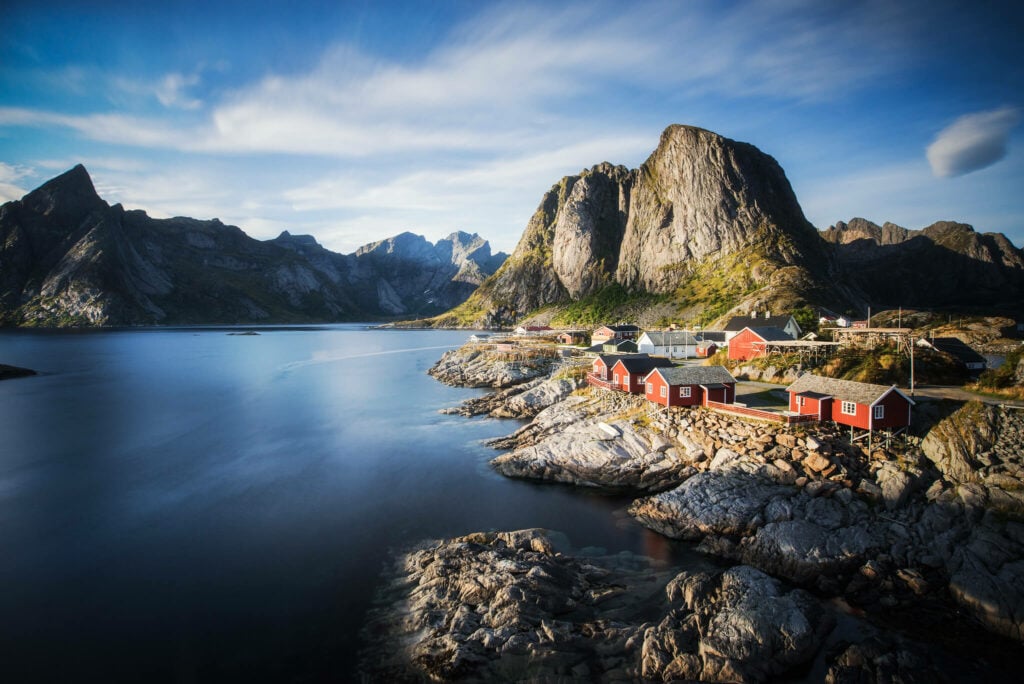
The beautiful Rorbuer at Eliassen Rorbuer.
Tips on Planning a Budget Trip to the Lofoten Islands
Lastly here are a few travel tips to save some money for planning a trip to the Lofoten Islands. Norway is an expensive destination, but there are a number of ways to make it more affordable or save money in the process. Here are my tips:
- Visit in the off-season: again, I’d highly recommend visiting in September.
- Rent a small car: you really do not need to rent a big car, most roads are narrow, so the smaller, the better. just make sure the luggage fits properly in the trunk
- Wildcamping: best of all, it’s free and you are right out in a great sport to enjoy sunset and sunrise. If you want a campsite and its amenities, they are reasonably priced too.
- Do not book accommodation in advance, look for last-minute deals: especially in the off-season, several locations will offer discounted prices. It’s better for them too, rather than having empty rooms. Also Look for hostels, there are quite a few on the Lofoten Islands.
- Avoid eating out: Norway is an expensive country and restaurant food is priced accordingly. Even hot dogs.
Conclusion – Planning a trip to the Lofoten Islands
The Lofoten Islands are an amazing travel destination if you are seeking natural beauty and breathtaking landscapes. It’s a real photographer’s Paradise. I hope this post helped you with planning your own trip to the Lofoten Islands. You’ll have a blast of a trip and quite likely you’ll start thinking about your next trip on your way back home already!
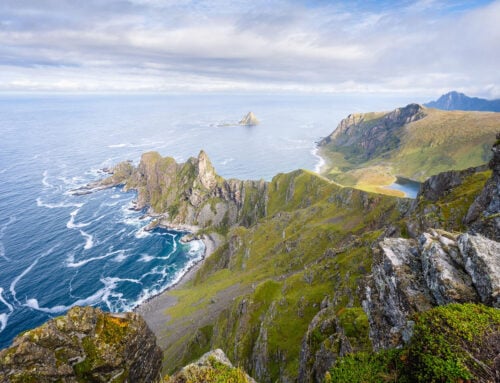
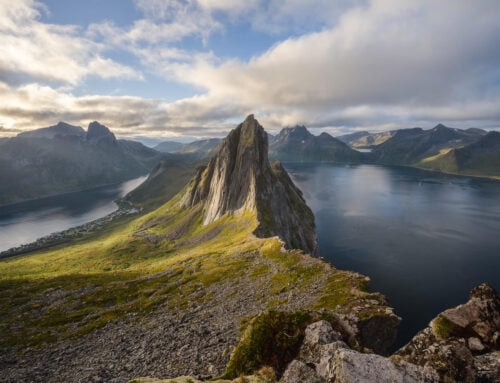

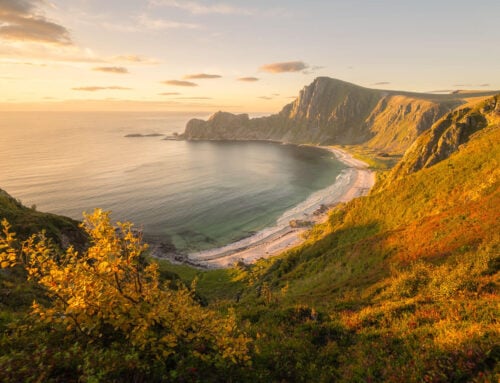
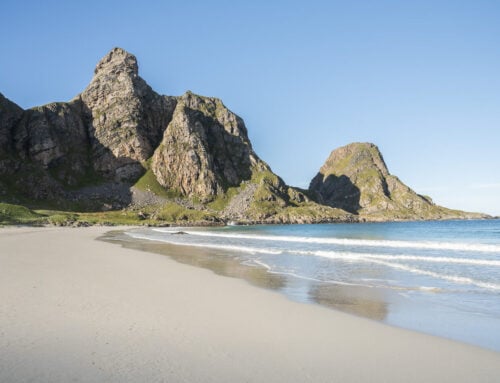

Thank so much for this article. It’s a seam of mine to visit. Hopefully next year. I will archive your article so that I have it handy when I plan the trip.
Thanks for making this very nice overview!
Here is a link to the Lofoten turist map, which shows where it’s legal to camp, etc: https://nordlandsatlas.maps.arcgis.com/apps/webappviewer/index.html?id=fab455cbf6e8441894efd4ccc99a0b8f
For those with a drone this is also useful: https://visitlofoten.com/en/droneguide/
Thanks for the comment and additional info. Quite a nice location you’ve got there :) Hoven is on my list too.